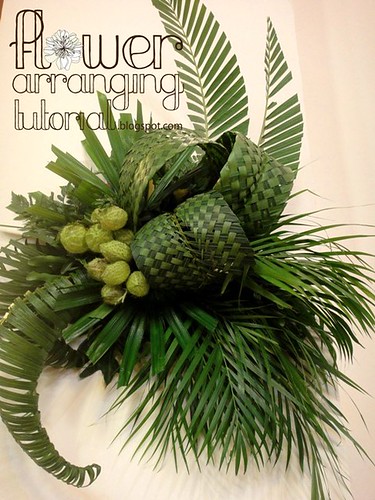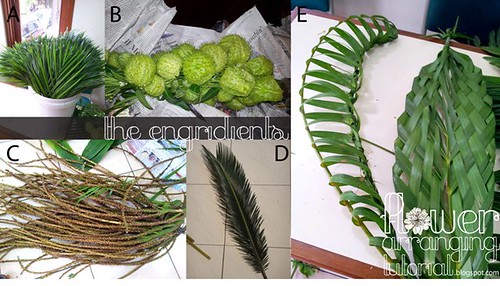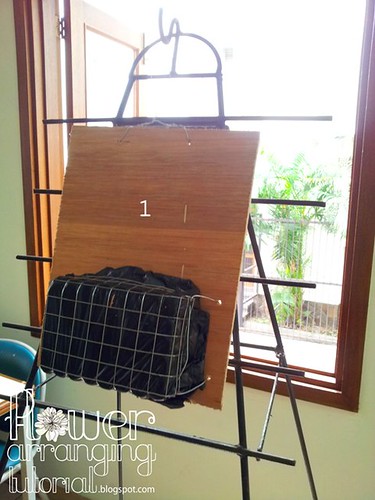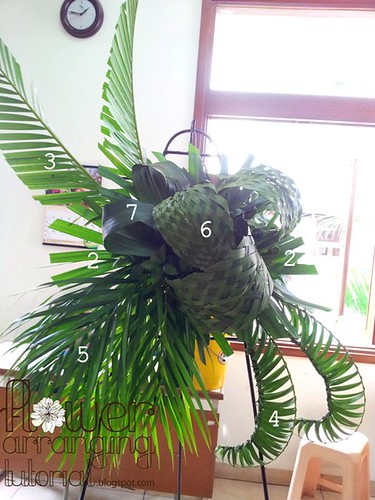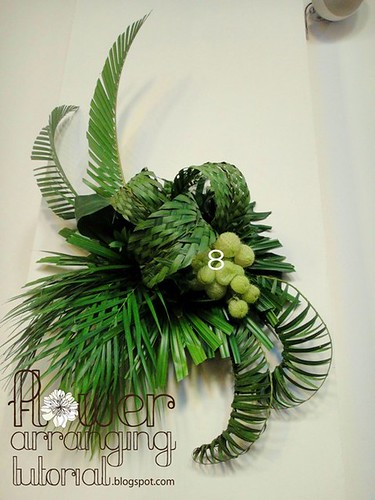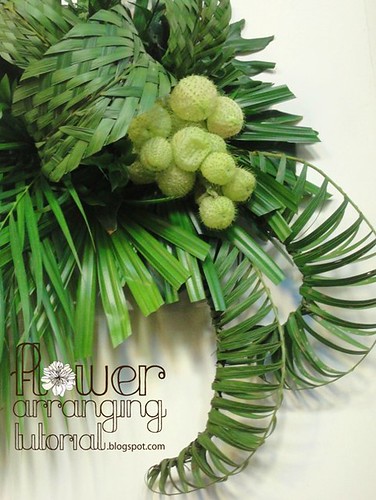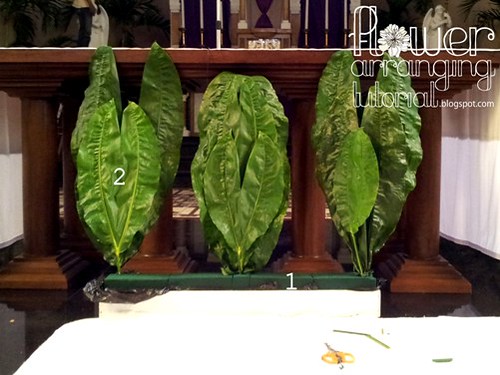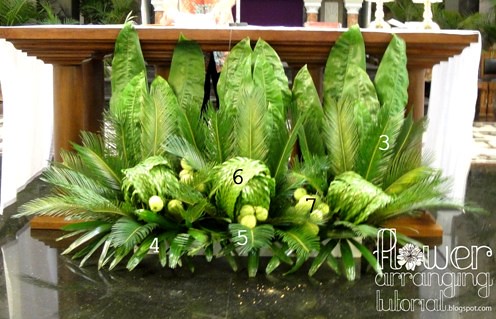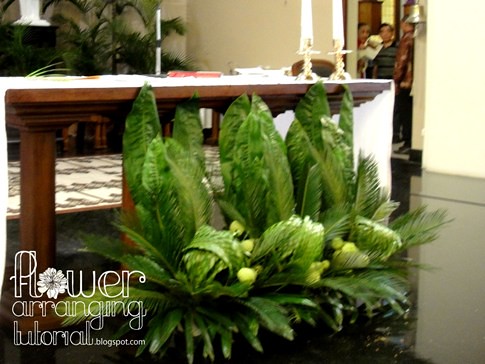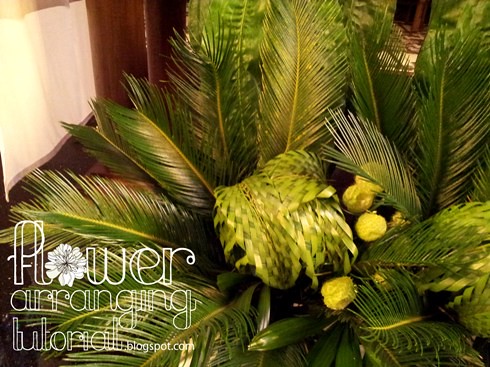
Since we’re in the Lenten Season,
so the theme for the decoration this time is for Easter. And the floral
designer is Mrs. Ida Hermanto. The concept is the flower arrangement that suitable
for Easter. As you know, Easter is identical with eggs, so Mrs. Ida also used
eggs in her design. The design is simple but unique. Since it’s quite big, so
we must concern about the construction well. It should be strong and firm or
can’t move easily so it can arrive safely along its delivery.
This flowers
arrangement is suitable for commercial as it takes time to make especially in
preparing the construction. It needs not only a lot of techniques of flowers
arranging such as grouping, basing, terracing and sheltering but also a lot of
materials which most of them not cheap . So, for the beginners who want to try,
I suggest to substitute some materials into the cheaper one, such as you can
change the roses with spray chrysanthemum, the curly lucky dracaena with salix
or any other twigs, use the usual green ivy in spite of the Hedera helix
variegate though the last will bring unique sensation by its unique color curly
leaves. You can also make your own bird nest to replace the sisal mesh that is
quite expensive.
Anyway, happy a try, guys …
The detail of colorful eggs
The detail of the leaves ie the
hedera helix variegata, the lilium variegate and the bi-color cordyline, not to
mention the ruscus leaves attached on the vase.
The materials used are:
(A) curly lucky dracaena, (B)
aspidistra leaf, (C) ‘Midori’ anthurium, (D) roses of ‘Avalance’ and ‘ Ilios’,
(E) floral wire, (F) sisal mesh or pressed sisal wrap, (G) some eggs painted
colorful.
Besides those mention above, you also need a plastic pot/vase, some
floral wet foam, a sphere floral foam (Ø
22 cm) then form it into the ‘egg’ shape, ruscus leaves to cover the plastic
vase, hedera helix variegata, bi-color cordyline, lilium variegata or in
Indonesia it is popular as lily paris leaves and some baby roses.
And these are the step by step
how to make it:
1. Prepare some ruscus leaves, then cut
them short, make sure the leaves have the same measure.
Take the plastic pot/vase. Attach
around the vase with double tape, then placed the ruscus leaves on the double
tape. Do it from top to down until the surface of the vase was all covered by
ruscus leaves. It will take some time to do this especially if you’d like to make
it look neat. The more patient you do the neater you’ll get.
2. Now the vase is ready to be filled with
some floral wet foam. (Remember, you must soak the floral foam into the water
some hours before until it absorb the water well)
3. Take the ‘egg shape’ of floral foam
then put it on the vase. Secure it by using chopsticks.
4. Double secure by placing 3 stems of
Curly lucky dracaena around the egg shaped foam. Now it cannot move left or
right. It will remain in its place. Always make sure that the construction is
sturdy before you're arranging. If it is not strong enough, then there’s
possibility that the flower arrangement can fall or break down on the way of
delivery, then we have to start over again which means a waste of time.
5. Take a sisal mesh, then form it by
using your fingers until it looks like a ‘nest’ shape. After that attach the
nest on the stems of curly lucky dracaena,
6. and if you think it’s been sturdy
enough then put the eggs on the nest. By doing this, you’re using sheltering
technique.
7. Now, take some roses of ‘Avalance’,
then cut the stems short, ± 6
– 8 cm below the flowers then placed them on the egg-shaped foam by using
basing technique. Do this until you cover almost the surface of the egg-shaped
foam, but remain it empty in some areas.
8. Then fill in the empty place with the
roses of ‘Ilios’. Now the egg-shaped
foam is all covered by the roses.
9. Take the anthurium of ‘Midori’ and
placed them in grouping technique on the left & right side. Make sure you
placed them in different height into harmony. Some of them were placed around
the edge of the vase.
10. Take some cordyline leaves, folded into 2
or 3 (if the leaf is long) then placed them between the anthurium around the
edge of the vase.
11. Give wire on the stem of Hedera helix
variegate so that it can be well arranged. Then put them on the left and right
side of the flower arrangement.
12. Take 2 of lilium variegata, then make 2
circle by using your palm, make sure the remain leaf on top, then secure it
with floral wire. Now you have a cute model of the leaf. Do some pieces of this model then placed them
into the empty place among the cordyline, anthurium and roses so that there’s
no foam seen now. Besides, by adding this cute model of leaf, the flower
arrangement becomes lively, not monotonous or just flat surface. (Good design
should consider the dimension whether depth, height or rhythm)
13. Take some stems of baby roses, placed
them near the curly lucky dracaena in a group. The height of the baby roses is
a bit higher of the white roses.
14. Finally, take aspidistra leaf, then fold
it right/left that looks like the reverse of a small triangle. Now the
aspidistra leaf has changed into a stem with a small triangle on top. Make 7
pieces of this model, then placed 5 of them near the baby roses in a group by
using terracing technique. It’s done.
Have a Happy Easter
for those who celebrate it.
The images were taken at the IPBI DPC Bandung Monthly Gathering – Feb 28, 2013
The floral designer’s Mrs. Ida
Hermanto.












